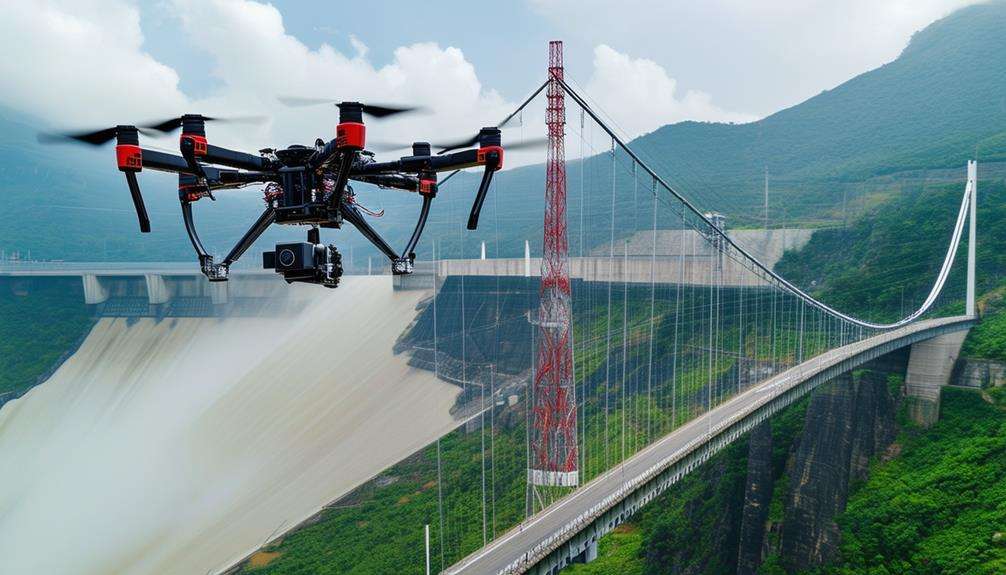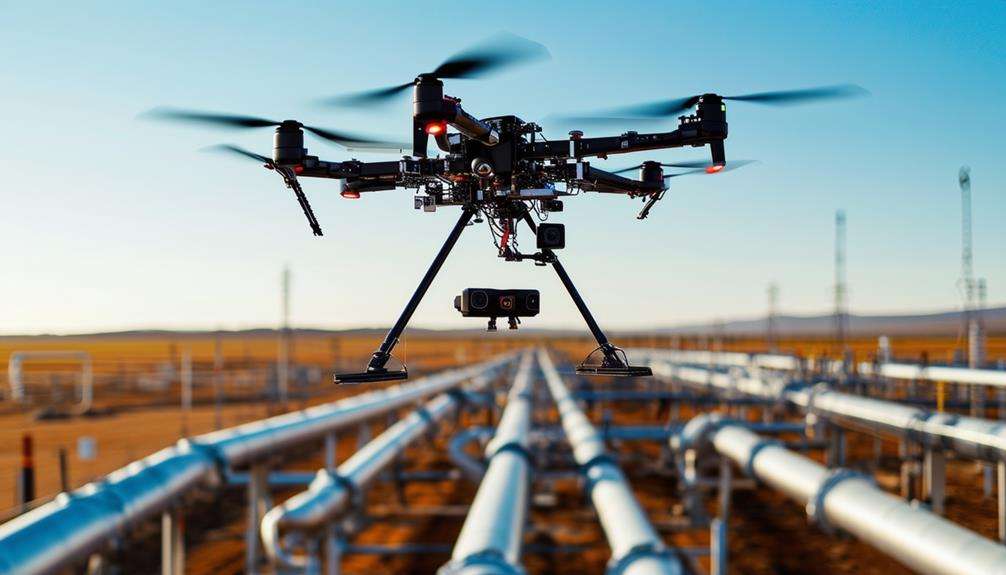Drones in Agriculture: Boosting Yields and Sustainability
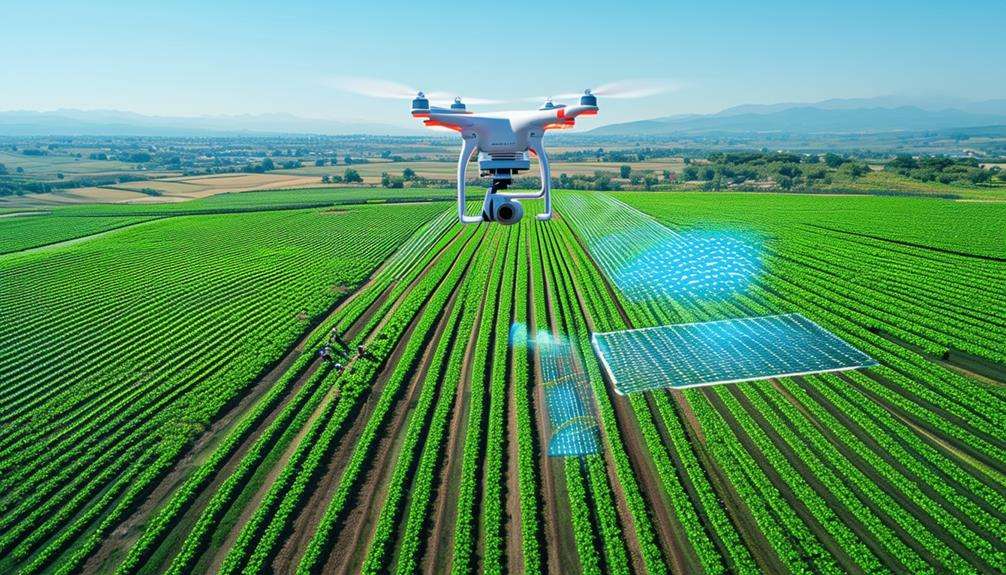
Imagine you're a farmer with the ability to monitor your fields in real-time, spot crop health issues before they escalate, and apply resources precisely where needed. Drones in agriculture are making this a reality, revolutionizing traditional farming methods.
These drones offer high-resolution imagery, soil mapping, and pest detection, all of which enhance efficiency and sustainability. By leveraging drone technology, you can make data-driven decisions that boost yield and reduce input costs. But how exactly do these devices operate, and what are the future implications for your farm?
Applications of Drones
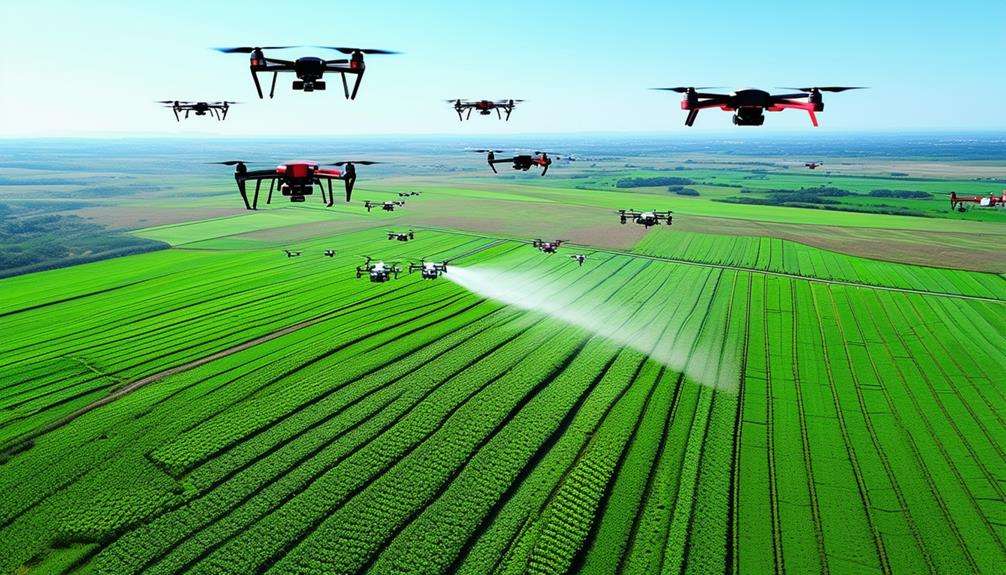
Drones in agriculture are revolutionizing the way farmers monitor crops, manage livestock, and map irrigation systems. Equipped with high-resolution cameras and sensors, these advanced tools enable the precise collection of data critical to farming operations. By capturing real-time footage and generating detailed GPS maps, drones provide comprehensive insights into agricultural landscapes, facilitating informed decision-making.
For crop monitoring, drones can assess plant health, detect pest infestations, and identify areas needing attention. This invaluable data supports activities such as planting and pest management, ultimately boosting crop yields. Precision agriculture techniques enabled by drones ensure that resources like water and fertilizers are used efficiently, promoting sustainable farming practices.
In livestock management, drones simplify the tracking of animal location and health, significantly reducing the time and effort required for manual checks. Additionally, drone-assisted irrigation mapping optimizes water distribution across fields, ensuring all areas receive adequate moisture.
As agricultural practices continue to evolve, drones are set to play an increasingly pivotal role. Their ability to provide detailed, actionable insights makes them indispensable for modern farming, enhancing both productivity and sustainability.
Precision Farming Techniques
Precision farming techniques enable farmers to optimize crop monitoring through the use of drones. Drones gather real-time data on crop health and soil conditions, allowing for precise resource management. This approach ensures that water, fertilizers, and pesticides are applied only where needed. Enhanced data collection from drones supports informed decision-making, leading to improved productivity and sustainability in farming operations.
Optimizing Crop Monitoring
Harnessing precision farming techniques through drone technology revolutionizes crop monitoring by providing real-time insights into plant health and resource needs. By implementing drones for crop monitoring, you can collect detailed data that highlights nutrient deficiencies and pest infestations, allowing for informed decisions to optimize fertilizer and pesticide applications. This ensures that each crop receives precisely what it requires.
Real-time monitoring enables early detection of issues, allowing for timely interventions that can significantly improve yields. Imagine spotting a nutrient deficiency before it stunts your crop's growth or identifying a pest infestation before it spreads.
Drone data provides several advantages:
- High-resolution imagery: Capture detailed images to assess crop health.
- Thermal imaging: Identify stress factors such as water scarcity or disease.
- Multispectral sensors: Detect nutrient deficiencies invisible to the naked eye.
- Precise mapping: Create targeted application maps for fertilizers and pesticides.
- Early warning system: Receive alerts on potential pest infestations or disease outbreaks.
Efficient Resource Management
Implementing precision farming techniques through drone technology ensures efficient resource allocation, reducing waste and enhancing crop yields. Precision agriculture allows for effective management of resources like water, fertilizers, and pesticides. Drones provide real-time data, enabling immediate adjustments and ensuring efficient farming practices. This approach not only optimizes crop production but also minimizes environmental impact.
Utilizing drone technology for detailed aerial imaging and mapping facilitates targeted management strategies tailored to specific crop needs. These strategies optimize crop growth by focusing resources where they're needed most, minimizing waste and ensuring uniform treatment across the field.
A significant benefit of this technology is the ability to make proactive interventions. Continuous crop health monitoring via drones allows for timely measures to address any issues. This proactive, data-driven approach helps maintain crop health and enhances overall productivity. Embracing precision agriculture improves resource management and promotes sustainable farming practices that benefit both yields and the environment.
Enhanced Data Collection
Drones have revolutionized data collection in precision farming by providing critical, real-time information about crops. Equipped with advanced sensors, drones deliver data on crop health, soil conditions, and pest infestations, enabling farmers to make informed, data-driven decisions.
Key Benefits of Using Drones in Agriculture:
- Early Detection of Crop Health Issues: Identify stress factors such as disease, nutrient deficiencies, and water stress before they become severe.
- Accurate Mapping of Soil Conditions: Analyze soil properties to optimize planting and irrigation strategies.
- Identification of Pest Infestations: Spot pest activity early, allowing for targeted interventions.
- Precise Application of Water and Fertilizers: Use data to apply resources efficiently, reducing waste and enhancing crop growth.
- Informed Decisions on Planting and Harvesting Times: Optimize yield by timing agricultural activities based on accurate data.
Sustainability and Productivity Gains:
Utilizing drone technology can significantly enhance farm sustainability. By optimizing water usage, reducing pesticide application, and improving crop yields, drones help farmers address potential issues before they escalate. This proactive approach ensures healthier crops and increased productivity.
Drone Technology Features
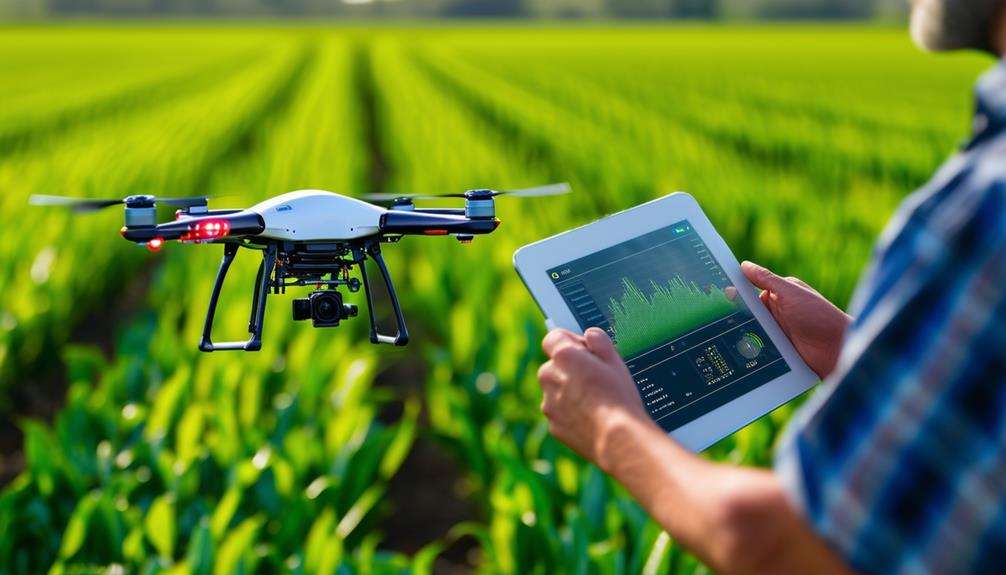
Drones excel in precision crop monitoring and efficient field mapping. Equipped with advanced sensors and AI-powered software, they provide detailed insights into crop health and field conditions. With autonomous flight capabilities, drones offer a seamless way to manage large and diverse agricultural landscapes.
Precision Crop Monitoring
Agricultural drones, equipped with infrared cameras and GPS systems, provide the precision essential for effective crop monitoring. These advanced features enable real-time assessment of crop health, allowing for quick, well-informed decisions. Data collected by drones is processed through specialized crop management software, significantly enhancing agricultural yields.
Imagine having these capabilities at your fingertips:
- Precision crop monitoring: Detect nutrient deficiencies and water stress early.
- Informed irrigation: Allocate water resources efficiently to minimize waste.
- Effective pest management: Identify and treat pest infestations before they spread.
- Optimized crop health: Regularly monitor plant growth and health to optimize care.
- Increased agricultural yields: Implement timely interventions to boost productivity.
Using drones in agriculture streamlines operations, from planning planting schedules to ongoing crop health assessments. Proactively addressing irrigation needs and pest management optimizes crop growth conditions. This not only increases agricultural yields but also contributes to a potential 10% improvement in global crop yields, according to a PwC study. Integrating these advanced features into your farming practices ensures you stay ahead of potential issues, leading to a more sustainable and productive agricultural system.
Efficient Field Mapping
Drones equipped with high-resolution cameras and GPS capabilities significantly enhance the precision and efficiency of field mapping. These advanced features allow for the collection of accurate spatial data and the creation of detailed maps, which are crucial for informed decision-making regarding planting, irrigation, and fertilization. This ultimately leads to improved crop yields.
Drone surveys provide valuable insights into various aspects of your fields:
| Feature | Benefit |
|---|---|
| High-resolution cameras | Capture detailed aerial imagery |
| GPS mapping | Ensure accurate spatial data collection |
| Thermal sensors | Identify areas with potential pest activity |
| Multispectral sensors | Analyze plant health and stress levels |
Thermal sensors on drones detect ground temperature variations, helping to pinpoint areas of potential pest activity. Multispectral sensors offer data on plant health, enabling early detection of stress and timely intervention. Additionally, drone surveys provide a comprehensive view of field topography and soil quality, facilitating more effective management practices.
Benefits for Farmers
How can farmers not benefit from the improved productivity and reduced costs associated with adopting drone technology in agriculture? By utilizing drones, farmers can access a variety of advantages that transform traditional farming practices.
Drones provide real-time data on crop health, nutrient deficiencies, and pest infestations, enabling timely and precise interventions. This leads to enhanced crop health, higher yields, and contributes to overall sustainability.
Precision agriculture facilitated by drones optimizes resource allocation, minimizing the environmental impact. Drones allow for efficient field monitoring, reducing the need for manual labor and lowering operational costs. A PwC study projects that drone technology could potentially increase global crop yields by up to 10%, highlighting its significance.
Consider these benefits:
- Enhanced crop health: Immediate data analysis helps address issues before they escalate.
- Higher yields: Targeted interventions result in more productive harvests.
- Cost savings: Precise application reduces the need for pesticides and fertilizers.
- Sustainability: Optimized resource use lowers environmental impact.
- Time efficiency: Faster field monitoring and data collection free up time for other crucial tasks.
Drones in agriculture aren't just a trend; they're a revolutionary technology for modern farming.
Future Trends
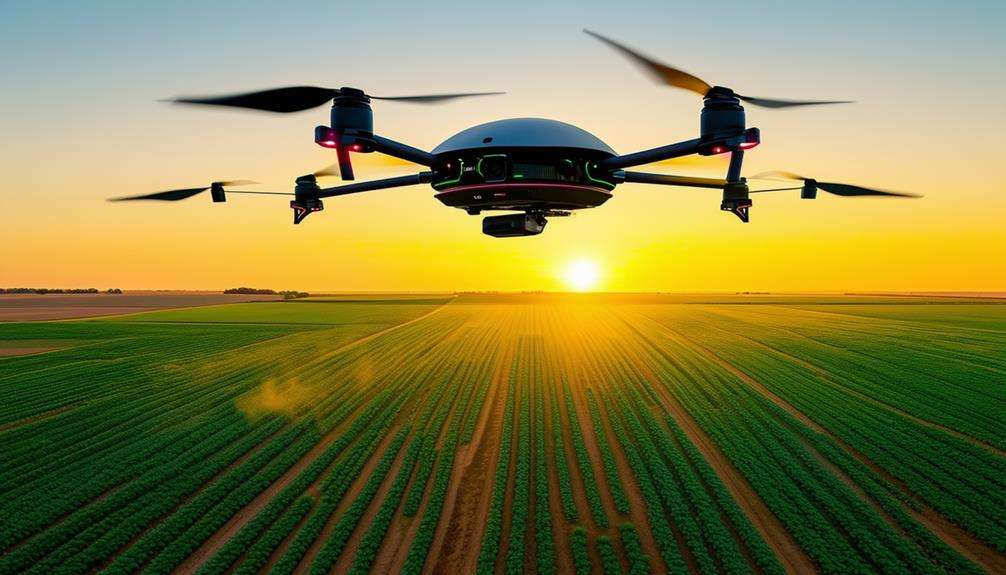
As farmers continue to reap the benefits of drone technology, the future promises even more transformative advancements for agriculture. Emerging trends indicate a significant shift towards AI-powered drones and advanced data analytics. These technologies will enable precision agriculture, allowing farmers to make informed decisions based on real-time data. Imagine drones that not only capture high-resolution imagery but also analyze crop health and predict optimal harvest times.
The global precision agriculture market is projected to reach $43.4 billion by 2025, with the agriculture drone sector alone estimated to be worth $32.4 billion. This growth signals a robust future for modern farming practices.
| Future Trends | Emotional Impact |
|---|---|
| AI-powered drones | Enhanced decision-making |
| Advanced data analytics | Increased efficiency |
| Sustainable agriculture | Environmental stewardship |
Implementation Considerations
Implementing drone technology in agriculture requires meticulous planning and attention to several critical factors. These include regulatory compliance, cost-benefit analysis, and operational efficiency. Here are the essential elements to consider for successful integration:
- Regulatory Compliance: Stay updated with all relevant airspace rules and local laws to ensure your drone operations are within legal boundaries.
- Cost-Benefit Analysis: Evaluate the financial aspects, such as purchasing, maintenance, and training costs, to determine the return on investment (ROI). Compare these costs with potential yield improvements and operational efficiencies.
- Permissions and Permits: Secure all necessary permits before deploying drones on your farm.
- Operational Considerations: Select certified drone models that meet industry safety standards and can be integrated seamlessly into your existing workflows.
- Data Processing Requirements: Prepare for the challenges of managing and processing the data collected by your drones.
Conclusion
By adopting drone technology, you're not just improving crop yields but also fostering a more sustainable farming practice. Drones enable precise, data-driven decisions, minimizing waste and maximizing resource efficiency. This results in healthier crops, reduced input costs, and a positive environmental impact. The future of agriculture is here, and it's within your reach. Embrace the opportunity to transform your farm with the power of drones.


